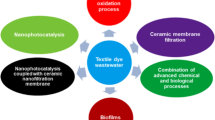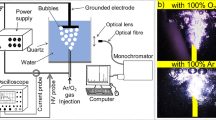Abstract
This study investigated the response of different-age biofilms developed on membrane surface to a chemical uncoupler 3, 3′, 4′, 5-tetrachlorosalicylanilide (TCS). Results showed that adenosine triphosphate (ATP) dissipation caused by TCS would promote different-age biofilms detachment, whereas chemically inhibited cellular ATP synthesis subsequently suppressed autoinducer-2 (AI-2) and extracellular polymeric substances (EPS) production. The extent of biofilm detachment was found to be closely related to AI-2-regulated EPS contents of bacteria. It was revealed that energy dissipation induced biofilm detachability was controlled by AI-2 regulated cellular communication via AI-2-mediated EPS secretion. This study would lead to a new cleaning strategy of biologically fouled membrane.










Similar content being viewed by others
References
Abee T, Kovacs AT, Kuipers OP, van der Veen S (2011) Biofilm formation and dispersal in gram-positive bacteria. Curr Opin Biotechnol 22:172–179
Adav SS, Lee DJ, Tay JH (2008) Extracellular polymeric substances and structural stability of aerobic granule. Water Res 42:1644–1650
Ahmed N, Petersen FC, Scheie AA (2008) Biofilm formation and autoinducer-2 signaling in Streptococcus intermedius: role of thermal and pH factors. Oral Microbiol Immunol 23:492–497
Chen GH, Leung DHW (2000) Utilization of oxygen in a sanitary gravity sewer. Water Res 34:3813–3821
Davies DG, Parsek MR, Pearson JP, Iglewski BH, Costerton JW, Greenberg EP (1998) The involvement of cell-to-cell signals in the development of a bacterial biofilm. Science 280:295–298
De Araujo C, Balestrino D, Roth L, Charbonnel N, Forestier C (2010) Quorum sensing affects biofilm formation through lipopolysaccharide synthesis in Klebsiella pneumoniae. Res Microbiol 161:595–603
De Keersmaecker SCJ, Sonck K, Vanderleyden J (2006) Let LuxS speak up in AI-2 signaling. Trends Microbiol 14:114–119
Dubois M, Gilles KA, Hamilton JK, Rebers PA, Smith F (1956) Colorimetric method for determination of sugars and related substances. Anal Chem 28:350–356
Flemming HC, Neu TR, Wozniak DJ (2007) The EPS matrix: the “house of biofilm cells”. J Bacteriol 189:7945–7947
Fredheim EGA, Klingenberg C, Rohde H, Frankenberger S, Gaustad P, Flaegstad T, Sollid JE (2009) Biofilm formation by Staphylococcus haemolyticus. J Clin Microbiol 47:1172–1180
Gao Y, Song JX, Hu BS, Zhang L, Liu QQ, Liu FQ (2009) The luxS gene is involved in AI-2 production, pathogenicity, and some phenotypes in Erwinia amylovora. Curr Microbiol 58:1–10
Jia XS, Furumai H, Fang HHP (1996) Yields of biomass and extracellular polymers in four anaerobic sludges. Environ Technol 17:283–291
Jiang B, Liu Y (2010) Energy uncoupling inhibits aerobic granulation. Appl Microbiol Biotechnol 85:589–595
Kaplan JB (2010) Biofilm dispersal: mechanisms, clinical implications, and potential therapeutic uses. J Dent Res 89:205–218
Karatan E, Watnick P (2009) Signals, regulatory networks, and materials that build and break bacterial biofilms. Microbiol Mol Biol Rev 73:310–347
Koutsoudis MD, Tsaltas D, Minogue TD, von Bodman SB (2006) Quorum-sensing regulation governs bacterial adhesion, biofilm development, and host colonization in Pantoea stewartii subspecies stewartii. Proc Natl Acad Sci U S A 103:5983–5988
Landini P, Antoniani D, Burgess JG, Nijland R (2010) Molecular mechanisms of compounds affecting bacterial biofilm formation and dispersal. Appl Microbiol Biotechnol 86:813–823
Liu Y (2000) Effect of chemical uncoupler on the observed growth yield in batch culture of activated sludge. Water Res 34:2025–2030
Liu Y, Yang SF, Tay JH (2003) Elemental compositions and characteristics of aerobic granules cultivated at different substrate N/C ratios. Appl Microbiol Biotechnol 61:556–561
Liu Z, Stirling FR, Zhu J (2007) Temporal quorum-sensing induction regulates Vibrio cholerae biofilm architecture. Infect Immun 75:122–126
Lowry OH, Rosebrough NJ, Farr AL, Randall RJ (1951) Protein measurement with the folin phenol reagent. J Biol Chem 193:265–275
Petersen FC, Ahmed N, Naemi A, Scheie AA (2006) LuxS-mediated signalling in Streptococcus anginosus and its role in biofilm formation. Anton Leeuw Int J G 90:109–121
Priester JH, Horst AM, Van De Werfhorst LC, Saleta JL, Mertes LAK, Holden PA (2007) Enhanced visualization of microbial biofilms by staining and environmental scanning electron microscopy. J Microbiol Methods 68:577–587
Pumbwe L, Skilbeck CA, Wexler HM (2008) Presence of quorum-sensing systems associated with multidrug resistance and biofilm formation in Bacteroides fragilis. Microb Ecol 56:412–419
Purevdorj-Gage B, Costerton WJ, Stoodley P (2005) Phenotypic differentiation and seeding dispersal in non-mucoid and mucoid Pseudomonas aeruginosa biofilms. Microbiol Sgm 151:1569–1576
Quinones B, Dulla G, Lindow SE (2005) Quorum sensing regulates exopolysaccharide production, motility, and virulence in Pseudomonas syringae. Mol Plant Microbe Interact 18:682–693
Rice SA, Koh KS, Queck SY, Labbate M, Lam KW, Kjelleberg S (2005) Biofilm formation and sloughing in Serratia marcescens are controlled by quorum sensing and nutrient cues. J Bacteriol 187:3477–3485
Rickard AH, Palmer RJ, Blehert DS, Campagna SR, Semmelhack MF, Egland PG, Bassler BL, Kolenbrander PE (2006) Autoinducer 2: a concentration-dependent signal for mutualistic bacterial biofilm growth. Mol Microbiol 60:1446–1456
Rickard AH, Campagna SR, Kolenbrander PE (2008) Autoinducer-2 is produced in saliva-fed flow conditions relevant to natural oral biofilms. J Appl Microbiol 105:2096–2103
Sakuragi Y, Kolter R (2007) Quorum-sensing regulation of the biofilm matrix genes (pel) of Pseudomonas aeruginosa. J Bacteriol 189:5383–5386
Sauer K, Camper AK, Ehrlich GD, Costerton JW, Davies DG (2002) Pseudomonas aeruginosa displays multiple phenotypes during development as a biofilm. J Bacteriol 184:1140–1154
Schauder S, Shokat K, Surette MG, Bassler BL (2001) The LuxS family of bacterial autoinducers: biosynthesis of a novel quorum-sensing signal molecule. Mol Microbiol 41:463–476
Steinberger RE, Allen AR, Hansma HG, Holden PA (2002) Elongation correlates with nutrient deprivation in Pseudomonas aeruginosa-unsaturated biofilms. Microb Ecol 43:416–423
Surette MG, Miller MB, Bassler BL (1999) Quorum sensing in Escherichia coli, Salmonella typhimurium, and Vibrio harveyi: a new family of genes responsible for autoinducer production. Proc Natl Acad Sci U S A 96:1639–1644
Sutherland IW (2001) Biofilm exopolysaccharides: a strong and sticky framework. Microbiology 147:3–9
Voet D, Voet JG, Pratt CW (1998) Fundamentals of biochemistry. Wiley, New York
Xiong Y, Liu Y (2011) Essential roles of eDNA and AI-2 in aerobic granulation in sequencing batch reactors operated at different settling times. Appl Microbiol Biotechnol. doi:10.1007/s00253-011-3565-z
Author information
Authors and Affiliations
Corresponding author
Rights and permissions
About this article
Cite this article
Xu, H., Teo, K., Neo, H. et al. Chemically inhibited ATP synthesis promoted detachment of different-age biofilms from membrane surface. Appl Microbiol Biotechnol 95, 1073–1082 (2012). https://doi.org/10.1007/s00253-011-3770-9
Received:
Revised:
Accepted:
Published:
Issue Date:
DOI: https://doi.org/10.1007/s00253-011-3770-9




